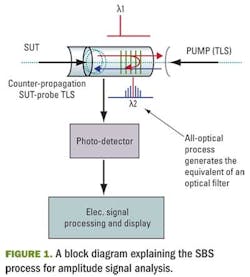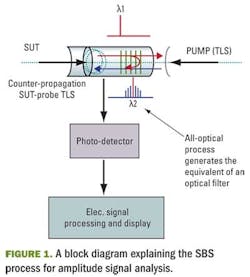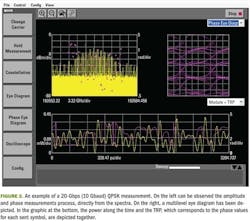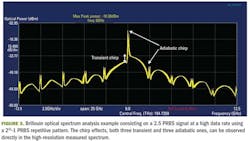New approach aids advanced 40/100-Gbps modulation format characterization
By Laura Martínez and Enrique Pellejer
Overview
Derived from stimulated Brillouin scattering, the Brillouin optical spectrum analysis technique enables phase and amplitude measurements directly from the optical complex spectra.
The large and growing demand for data transmission has put a lot of pressure on backbone networks, which must transport an ever-increasing amount of traffic over long distances, yet make the most of the already installed fiber. This trend has generated many new challenges, with spectral efficiency playing a major role. Not surprisingly, the number of companies and research centers involved in this field has grown rapidly, each looking for new and more efficient ways of using available bandwidth.
The first step to meet these needs resulted in changing the idea of WDM systems. The development of DWDM introduced more data channels in the same available bandwidth. These kinds of networks have been developed in parallel with their integrant components. Optical filters became more powerful and the laser sources more accurate, while optical amplifiers offered higher gains and better performance.
The second step has focused on the study and development of new modulation formats in which both the phase and the amplitude are used to carry the information. In recent years, a movement to the phase field has taken place. The simplest phase modulation format (binary phase-shift keying, or BPSK) has opened the door to new multilevel ones, also known as quadrature amplitude modulation (QAM). These formats make use both of the phase and the amplitude to send not only the single bits but the symbols encoding several bits. Though these modulation formats are common in other applications, such as radio communications, in optical communications there is still a long way to go before they become widely available.
As a consequence of this evolution, the developers of the new 40/100-Gbps subsystems are demanding new, high-technology instruments able to characterize the optoelectronic devices under research.
Brillouin technology and complex spectrum analysis
One such instrument, the Brillouin optical spectrum analysis tool, is based on a well-known, non-linear effect: stimulated Brillouin scattering (SBS). When a high-power, narrow-linewidth beam (pump) is introduced in a fiber, part of its light is backscattered (Figure 1). If an additional signal (the signal under test, or SUT) is introduced in a counter-propagating way, the phenomenon is intensified and the backscattered light grows proportional to the amplitude of this second beam. The interaction occurs in a very narrow bandwidth of 10 MHz, hence resulting in a filtering process.
In addition to a wavelength shift due to the Doppler effect, there is a power transaction between the beams that results in the amplification of the SUT. If the pump is swept across a certain wavelength range, the spectral components of the SUT are filtered and amplified with the 10-MHz resolution of the Brillouin effect gain profile. Synchronized low-frequency detection is required to obtain the optical spectrum with extremely high resolution.
With this technique, all the filtering process takes place in the optical domain. There is not an optical-to-electrical conversion and spectral information is directly acquired from a simple detection stage. Moreover, there is no residual spectral information coming from the pump source as occurs in heterodyne-based techniques and only the information coming from the SUT is filtered and detected.
An evolution of this technique led to the invention of a new method to measure not only the amplitude, but also the phase of the signal under test. This variation of the Brillouin spectral analysis is similar to the SPIDER techniques for analysis and characterization of the optical field of ultra short pulses.
The method is still based on the Brillouin filtering process, but now a double pump is swept across the signal under test. This double pump, which comprises two spectral lines separated by a certain frequency, simultaneously filters and amplifies pairs of components of the SUT. The phase between them is calculated after self-heterodyne detection. Once all the relative phases between spectral components are measured, an absolute reference is set to obtain the phase information along the whole SUT.
The amplitude and phase information are now known, measured in the frequency domain. This complex information of the signal enables, by applying simple inverse fast Fourier transform (IFFT) techniques, the retrieval of the time-domain complex information of the modulated signals, including power and phase. Thus, specific parameters can be easily calculated and depicted, like the corresponding eye diagrams, constellations, time-resolved chirp, etc.
This method requires optical signals to be composed by repetitive patterns in the time domain, which turn into spectral lines forming a frequency comb in the spectral domain. The frequency of separation between these lines is equivalent to the pattern repetition frequency. All these lines are swept by the double sweeping filter, which allows extracting the relative phase between them, after the photodetection and acquisition.
Nevertheless, and going back to the technical requirements, it is important to stress that the pattern repetition frequency has some restrictions. Due to the general idea of the technique, the number of measured phases must not exceed a reasonable number if we want to maintain high quality levels in the measurements.
Main applications and general performance
Before going into details of the main applications, it is important to point out the advantages of the technique and also the special features the direct spectral analysis provides. It is true that for modulation format analysis and, in general, for all parameters related to time domain, most of the optical systems and subsystems, developers are used to working directly in the time domain, with the aid of previous optoelectronic conversions and demodulation processes.
However, the possibility of dealing with the phase and amplitude directly from the optical complex spectra offers the possibility of analyzing different aspects of the communication signals in real time, such as implicit quality parameters of the optoelectronic devices, fiber physical effects affecting the signals, etc.
Since this technique enables the user to deal directly with the complex spectrum, the equipment based on this technique is mainly oriented to universities and research centers that work on the development of optoelectronic devices and the analysis of complex modulated signals. In general, it is useful for any topic related to the characterization of single components or subsystems for optical communications.
Focusing on advanced modulation format analysis, the high resolution of the technique (0.08 pm) and the high dynamic range (more than 80 dB) provide better performance in complex analysis. The amplitude- and phase-modulated signals can be characterized just by using the amplitude and phase values obtained directly from the spectrum. Any kind of phase- and/or amplitude-modulated signal can be measured if they obey the pattern requirements. In practice, on/off keying (OOK), differential phase-shift keying (DPSK), and differential quadrature phase-shift keying (DQPSK) modulated signals in their non-return-to-zero (NRZ) and RZ versions at rates of up to 40 Gbps have been tested (Figure 2). Nevertheless, this is just the beginning. Different research laboratories plan to measure other modulation formats at higher rates.
Bear in mind that the Brillouin technique is a more general analysis tool that covers many more applications related to optical communication signals and active optoelectronic devices. These include, basically, all kinds of laser characterization, such as pulsed laser spectra, distributed feedback spectral shape, tunable laser sources, Fabry-Perot periodic structure, and very long pseudo-random bit sequence (PRBS) data modulated signals (either from optoelectronic or electro-absorption technologies), and DWDM systems (filtering, optical signal-to-noise ratio in-band measurement, etc.). Figure 3 provides an example.
Spectral domain versus time domain techniques
To understand the aforementioned target applications of this technique, it is important to clarify the differences from the other techniques used in modulation format analysis.
Real-time oscilloscopes capture the entire waveform when a trigger event arrives, working as an analog-to-digital converter (ADC) with a high sampling rate that determines the sample spacing. The sampling rate has to be much faster than the maximum frequency of the signal to be measured, thus limiting the measurement bandwidth. This kind of oscilloscope usually has a maximum measurement bandwidth slightly higher than 10 GHz.
For higher measurement bandwidth an “equivalent time sampling oscilloscope” can be used. In this case, the signal to be measured needs to be a repetitive pattern. A trigger at the repetition frequency has to be provided, and this trigger has to be synchronous with the data. The oscilloscope will acquire one sample per trigger, the sampling instant being slightly delayed from the next trigger arrival. This way, one sample is measured from each signal’s period and stored to its corresponding position in memory. After a number of periods, the complete pattern will be stored in memory. Electrically, bandwidths achieved can be incremented to several tens of gigahertz using this technique.
If higher bandwidths are required, optical sampling must be implemented, in addition to the equivalent time sampling technique. Newly arrived optical sampling oscilloscopes obtain measurement bandwidths of hundreds of gigahertz.
On the other hand, since every signal can be represented in the spectral domain as a complex function of the frequency, if we have the means to measure this complex spectrum, we can retrieve the signal in the time domain. The signal obtained in this way is a complex function of time, so we have not only the amplitude variation of the signal as a function of time, which would be the only thing that could be measured with an oscilloscope, but also the instantaneous phase of the signal as a function of time. The measurement bandwidth has no limit except for the measurement range of the optical complex spectrum analyzer.
CONCLUSION
The high-resolution Brillouin optical spectrum analysis technique provides unique features when dealing with optical communication signals and where complex analysis is required. The high-resolution analysis and the all-optical nature of the technique enable the acquisition of the phase and amplitude spectrum of the modulated signals and, by simple mathematical tools, the retrieval of the time-domain information and related parameters of interest.
The main applications include the analysis of signals from optoelectronic devices and, especially, on modulated signals either from optoelectronic or electro-absorption modulators. Thus, this technique enables an accurate and complete characterization of optical communication subsystems by offering a large amount of direct and indirect measurement possibilities.
Laura Martínez is sales and marketing manager and Enrique Pellejer is product manager at Aragon Photonics Labs S.L..
Links to more information
Lightwave: Optical Constellation Analyzers Tackle Complex Measurements
Lightwave Webcast: Test Strategies for 40G/100G Technology Development



